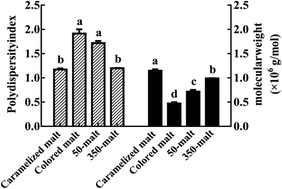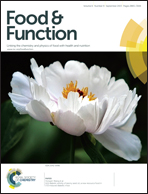Barley malt increases hindgut and portal butyric acid, modulates gene expression of gut tight junction proteins and Toll-like receptors in rats fed high-fat diets, but high advanced glycation end-products partially attenuate the effects†
Abstract
Barley malt, a product of controlled germination, has been shown to produce high levels of butyric acid in the cecum and portal serum of rats and may therefore have anti-inflammatory effects. The aim of the study was to investigate how four barley malts, caramelized and colored malts, 50-malt and 350-malt, differing in functional characteristics concerning beta-glucan content and color, affect short-chain fatty acids (SCFA), barrier function and inflammation in the hindgut of rats fed high-fat diets. Male Wistar rats were given malt-supplemented high-fat diets for four weeks. Low and high-fat diets containing microcrystalline cellulose were incorporated as controls. All diets contained 70 g kg−1 dietary fiber. The malt-fed groups were found to have had induced higher amounts of butyric and propionic acids in the hindgut and portal serum compared with controls, while cecal succinic acid only increased to a small extent. Fat increased the mRNA expression of tight junction proteins and Toll-like receptors (TLR) in the small intestine and distal colon of the rats, as well as the concentration of some amino acids in the portal plasma, but malt seemed to counteract these adverse effects to some extent. However, the high content of advanced glycation end-products (AGE) in caramelized malt tended to prohibit the positive effects on occludin in the small intestine and plasma amino acids seen with the other malt products. In conclusion, malting seems to be an interesting process for producing foods with positive health effects, but part of these effects may be destroyed if the malt contains a high content of AGE.

- This article is part of the themed collection: Probiotics, Prebiotics and Gut Health

 Please wait while we load your content...
Please wait while we load your content...